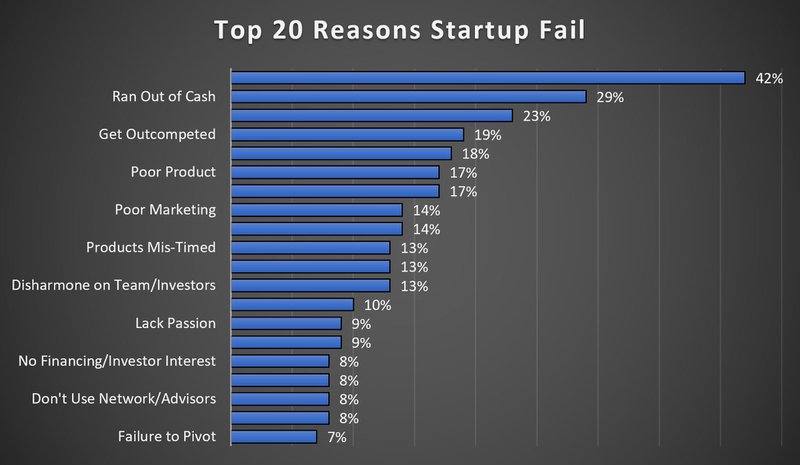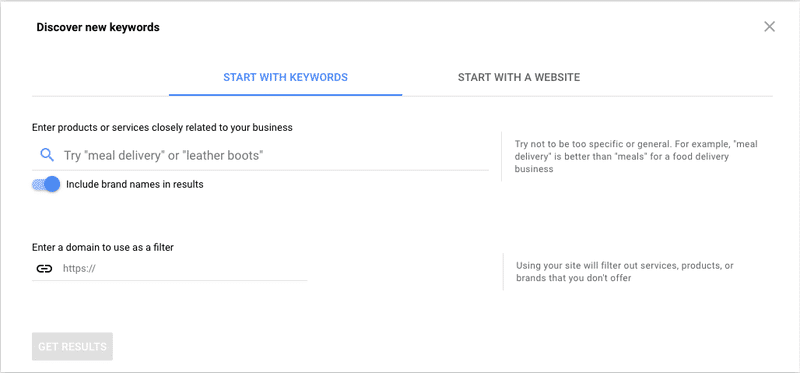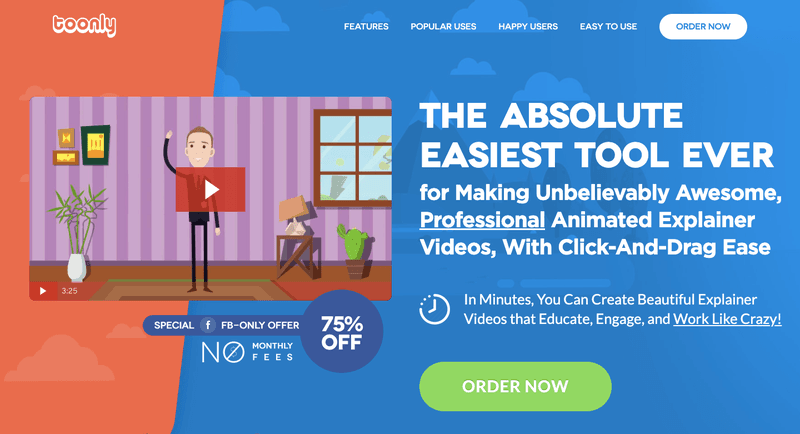Understanding how to create a startup based on a great idea is complex. Ideas can come from anywhere. Inspiration is everywhere around us, and we can even combine things from daily life to think of something that would become a great business.
Unfortunately for far too many budding entrepreneurs, those dreams can turn to dust.
A Venture Capital DataBase firm specializing in startups – CBInsights – studied small business failures and concluded the following twenty reasons for the demise.

Creating your own successful small business is the stuff of which dreams are made. However, we live in a time when building a great product, finding the right audience, getting it out there, and promoting it have never been so difficult. So how do you avoid becoming a statistic in a future study of small business failures?
How to create a successful startup?
If you feel ready to enter the startup world, read this article carefully to avoid joining the failures statistics.
Here we list the steps you need to take to create your successful startup:
- Analyze If The Problem Solved by Your Idea is Important Enough
- Consider The Growth Of The Market
- Take Action Upon The Idea Right Away
- Target The Right Audience
- Learn About Your Audience
- Know Your Competition
- Build a Minimum Viable Product
- Ask for Feedback
- Take Action After Feedback
- Keep the Patience
- Have a Marketing Plan
- Launch As Soon As Possible
- Control the Cash
- When Launching, Offer Something of Value
- Use A/B Test
- Organize The Startup To Do’s
- Plan Your Time
- Hire For Growth
1) Analyze If The Problem Solved by Your Idea is Important Enough
First, find a problem and then create a product around it. But also be 100% sure that it’s not just something only you struggle with, but a common issue.
Every successful product you’ve ever heard of is built to solve a specific problem many people share. It may save customers’ time and money, help them deal with something, alleviate pain, or do a difficult task.
Whatever it is, there’s a fundamental problem behind it. So be specific about yours.
Usually, the best startups are the ones whose creators defined a problem they also shared and cared about, and they found a way to fix it to help others who struggle with the same issue. So choose yours carefully and make sure enough people have it as well.

Once you have the problem in front of you, find out how your future development will help people deal with it. Be specific.
That will also help you with your unique selling proposition and with any sales copy or promotion you’ll ever do to market it.
2) Consider The Growth Of The Market
In the process of validating your startup business ideas, you certainly need to think if the market is attractive enough. Now it’s time to do your research. And the Internet offers plenty of opportunities for that.
First, check out the demand using Amazon’s top products in this category and whether they have enough reviews.
Try Google Adwords Keyword Tool to see how often people search for this term. Use social media, forums, and any place online where people spend a lot of time to see what they talk about the most. Look for the hashtags they use, how they react to promotion in this field, etc.

Have a vision for the future too. Check how things will be in the market for even ten years from now.
If it’s an evergreen problem, and there have been products made to fix it for a long time, and people are craving more solutions and options, then you’re all set.
Check Google Trends to see if the item has a growth trend search.

But if you’re offering something that goes together with a technology that’s trending only now, then a year from now, people may not be interested in it anymore.
3) Take Action Upon The Idea Right Away
We all have tens of ideas daily, and a few of them are million-dollar ones. But we need to notice which are worth it and should be turned into reality.
Validating a business idea is what initiative is all about.
You can’t understand how to create a startup if you don’t try it. It would be best to start building the product, doing your research, getting to people, and asking them what they think.
After that, see whether the whole thing is profitable and has a demand. That’s a must for a few reasons.

First, you’ll save yourself a lot of time and effort in the future by leaving some ideas behind, simply because you’ll realize they won’t make it in the real world. No matter how great they sound.
Second, you’ll build momentum and thus keep taking action. And last but not least, you’ll expand your vision by hearing what people think about it.
Keep in mind that an idea without action is just that – an exciting thought in your head – one of many. But we can create great products and get them in the hands of the right people, who help us contribute to the world by doing our best work.
4) Target The Right Audience
Choose your audience. If you’re too broad, you won’t be efficient in developing your product. You can fail to understand your users’ needs, and you will not solve their problems efficiently.

There is a risk of being superficial for all audiences, allowing competition to better attend to your future consumers.
Who is your primary target?
Teenagers? Travelers? Engineers looking for a job?
When your startup takes off, you can think about reaching other audiences. However, it’s imperative to focus on the scarce resources you have in your pocket to reach your target.
5) Learn About Your Audience
If the top reason for startup failure is the lack of market necessity, it seems obvious you should determine consumer targets and needs. Who would be interested in buying whatever it is you have to sell?

To attract and keep customers, you need to take the time necessary to know their wants and needs. Customer service is vital to any business, and the more you know about your customers, the better you will be able to serve them.
6) Know Your Competition
Would you open a coffee shop right across the street from another coffee shop? Not likely, but you could have unknown competitors on the other side of the world in the Internet age.

Researching the competition is a normal part of a start-up business plan that needs to extend beyond existing competitors. You also need to be aware of the ease with which whatever you are planning to introduce to the market could be copied if you experience success.
7) Build a Minimum Viable Product
A more straightforward product or a prototype is critical to validate your startup business ideas. Don’t wait until you have the final version.
Instead, build just a part of the product and get it out there as soon as possible so you can see if there is any interest. Feel free to keep working on it and improve it if there is. Then release that sooner too.

Add features and upgrade it all the time from then on as innovation must become a habit in today’s startup world, where things change quickly.
8) Ask for Feedback
Now it’s time for feedback. You can’t keep going without it.
It’s the most valuable thing people can give you at this point, so make sure you give them something in return for it. It may be a free version of the product or a discount or let them use it for a month before they have to pay. They will have an essential role in validating your startup business ideas.

See what your users like about it, but focus on what they don’t like. And listen to their reaction carefully. Always ask why. Analyze the reasons. Make adjustments accordingly and ask them again whether it’s better.
With this information in mind, you’ll know some people would pay for your product or service. This means there are many more out there you need to present it to. That’s when you can start setting goals, gather a team, create a productive working environment, and start taking action.
9) Take Action After Feedback
Now that you have it make the most of it. Especially the negative ones. Ask your customers specific questions about every feature and even side things like your site, the checkout page, and the sales copy.

Then, start analyzing the feedback and improve or add features to your product accordingly. Send them every new version of it for free too. That’s how you’ll keep receiving feedback and know it’s honest.
Businesses exist because of their customers. Remember that at any stage of your journey and cherish your clients.
10) Keep the Patience
The whole process takes time, often too long for the average person’s ability to wait.
Some startups have taken up to a decade of people’s life. But we’re talking about big things here, which may start small and take years to be built and scaled.
They turn into something that changes the world and is used by millions with great effort.
Let’s use the example of a website or app. Building traffic for a site, in the beginning, is challenging. Remember that besides your family, nobody knows your product.
You’re unknown on search engines, you don’t have a strong brand, and nobody has used your product yet. Don’t be ashamed to use some Marketing tools initially, like pay-per-click or social media ads, for example.

Start small to test each tool. Don’t invest a lot of money without being sure this is the right one for your business. It will help you build a reputation online, and If you keep up the excellent job, the results will come. Hard work and persistence have to go side by side, and they can pay off together.
So if you’re serious about launching a startup, go for it. But if working hard for months doesn’t sound very convenient to you, or if the thought of having to wait a lot before the money starts coming scares you, then this is not for you.
11) Have a Marketing Plan
We’ve touched on the increasing costs of online advertising, but there are plenty of affordable techniques for your business to get its name, product, or idea out there.
Prepare your marketing plan within your startup budget, so you won’t burn money without knowing the risks and the cost of acquiring new clients.
Contests are excellent ways to build up email lists, contact info, or even your audience’s personality profiles. A brand new Apple TV sounds like a fantastic prize, but it will cost you as little as $200.
Keep the hoop users have to jump through super simple (like following your Twitter account and retweeting the contest) to gain the most massive audience.

Fiverr is a great way to obtain advertising material at a low price. Fiverr is also an excellent source for unique marketing ideas. People offer to sing your jingle, create a youtube video, or boost your website for as little as five bucks. You can accomplish everything under the sun through Fiverr.
With costs that low, you can afford to hire many people to do several campaigns. This way, you can try everything before you commit to the most effective marketing plan.
12) Launch As Soon As Possible
You’ll never build the perfect product or create the ideal service. And if you try, you’re destined to procrastinate for a long time. But time is our most precious resource. There’s way too much competition to wait for the right time to launch in business.
Procrastinating is one of the main reasons for Startup failures. The right time is when you have the first version of your product and can get it out there so people can start using it. Ensure you position the product to the right audience and communicate the main benefits with the right price.

That’s your minimum viable product, and it’s the way every successful company is doing it today. You don’t need to make your first customers pay. It would be great to have them as beta users and let them use your product for free in return for their valuable feedback.
Too many startups have failed because they’ve waited too long to launch. Don’t be another one.
13) Control the Cash
Regardless of your operating capital size, it would be best if you treated every nickel with respect. Many start-ups hemorrhage cash while waiting for enough revenue to generate a profit. It means no frills of any kind.

Arguably, Sam Walton started the most successful new business of all time, and Walmart’s office headquarters had plastic chairs and plain tables for desks. However, Walton is legendary for investing early on in sophisticated computer systems that allowed his business to grow.
So invest smartly. Maybe you can use crowdsource marketing instead of hiring an exclusive marketing agency. Or even outsource part of the job to freelancers.
Controlling your expenses, in the beginning, will give you more time to grow.
14) When Launching, Offer Something of Value
People love the idea of getting something for nothing. CEOs, buyers, IT professionals – whoever your target audience may be – are people too.
Depending on your business, you can use white papers to promote your concept or highlight why they need your business.
Free trials are another great way of grabbing attention. Limited function, limited time, or limited features are all valid if you provide a software service. If you don’t, perhaps a free one-on-one consultation highlighting exactly how you can help the prospective client will be the best solution.

Consultations are brilliant because it allows you to know your audience’s needs guiding them in your direction. When in doubt: FREE grabs attention.
15) Use A/B Test
Speaking of trying campaigns before you commit, you can use a couple of paid advertisements to test your product. I’ve run campaigns to check product names on Facebook in the past.
For a few hundred dollars, I was able to find the product name that acquired four times more clicks than the other four options combined. It substantially helped promote our mobile app and achieved 35,000 downloads a day!
You can test more than just names. Icons, art, copy – be sure to check only one thing at a time.

If you test more than one thing, it will mean you won’t have a clear answer. It might have been a name that improved the click-through or just an icon. Keep everything simple.
16) Organize The Startup To Do’s
In the early days of building a small business, most owners perform a wide variety of roles, in some cases right down to the mundane chores of sweeping the floors!
If you are someone who has lived a life searching through a cluttered workspace, how can you expect to juggle the need to get done with the necessity to grow your business?

The skill of keeping your activities and tools organized rarely relates to small businesses. If you look back at the reasons for failure, how many of those could you tackle without being organized? Perhaps, because it is assumed only the well-organized would be brave enough to take the plunge.
In our view, being organized is the necessary foundation on which everything else is built.
17) Plan Your Time
A common complaint among small business owners is that there are not enough hours in the day. A daily plan helps to maximize the time you have.
You can research many conventional planning systems on the Internet, with most using a prioritizing system at their core.

Productivity tools and software work pretty well because they save people time, and time is money when we talk about business. So it’s worth paying a high price monthly just to let technology do some of the work you used to do for hours.
Whatever you choose to do, don’t make the fatal mistake even experienced business owners sometimes make. That is to make the plan and then put it in a drawer and forget about it.
Daily plans need to be reviewed at the end of the day to determine what worked and what didn’t and then revised accordingly.
18) Hire For Growth
The team is the heart of your startup. If you don’t know how to choose the best talent, you won’t understand how to create a startup.
Venture capitalists, in general, prefer Startups that have at least two co-founders. Many successful companies started with a minimum number of two people: Airbnb, Facebook, Pinterest, Twitter, etc.

In theory, small business owners reach the point of being ready to hire when adding an employee can generate additional revenue.
In practice, a rigid application of this approach ignores the possibility you, as the owner, are in the best position to directly generate revenue, which suggests it makes sense to hire someone to sweep the floors if it gives you more time to interact with customers directly.
To hire the right way, create a standard hiring process (resume evaluation, experience evaluation, and interviews), evaluate the personality, and ensure the new employee can adapt to your company’s culture.
Final Thoughts: How To Create a Startup
We live in a world with so many opportunities, and there are tons of options for anything. But all that can also distract us from the things that work.
Of course, you’ll need to be ready to do the hard work too. Without it, nothing will stick without enough time, patience, initiative, and dedication.
You may be ready to take action upon one of your many ideas, but you need to make sure there’s a demand for it. Analyze whether or not people need that and are willing to give money for it.
Way too many startups have failed because they started working on an idea and turned it into reality without validating it first. That means they wasted time, effort, money, and resources. And anyone can’t take that back.
However, take some time to plan and do your research carefully. Also, evaluate the time and money you will spend on your project pretty soon.
Never forget that there’s too much of everything out there already. Millions of people are creative and motivated enough to build valuable and unique products, and thousands of companies come up with the next best thing on the market daily.
Burnout comes when haggard small business owners are simply not enjoying themselves. Look for ways to treat yourself in some way upon accomplishments. Take time away to regenerate your “batteries.”
So you’ll need to be sure that your idea has potential and is worth working on. Luckily, there are ways to validate your startup business ideas quickly.

Christian has over ten years of experience in marketing agencies. Currently, he has been dedicating his time to a tech startup and also writing for major publications. He loves podcasts and reading to keep up with the latest trends in marketing.

Thanks for sharing this article about creating a startup! Very informative.
You’re welcome!